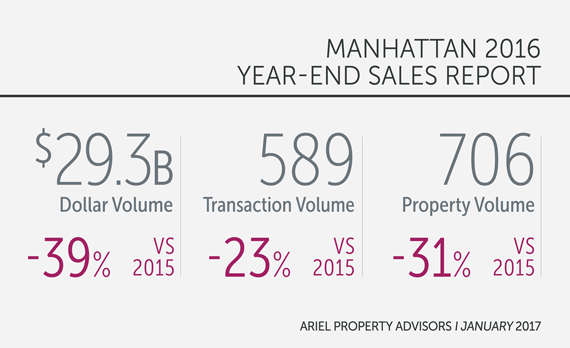Trending
Post-Stuy slide: Manhattan multifamily market decelerates in 2016
Transaction activity sank below 2015 and 2014 levels: Ariel Property Advisors

Manhattan’s multifamily market decelerated in 2016 from a blockbuster 2015, but pricing remained steady, according to a new year-end report from Ariel Property Advisors. The multifamily market saw $6.9 billion in dollar volume for the year, accounting for 24 percent of the borough’s investment sales.
There were 245 multifamily deals involving 323 properties, a drop of 16 and 32 percent respectively from 2015, and beneath 2014 levels as well. The $6.9 billion in dollar volume represents a steep 45 percent drop-off form the previous year, and 8 percent increase from 2014.
However, the decline narrows to 3 percent when excluding the $5.3 billion purchase of Stuyvesant Town-Peter Cooper Village, which comprised a whopping 45 percent of 2015’s dollar volume. The 2015 boost from the Stuy Town mega deal accounts for some of 2016’s declining year-over-year figures.
Pricing indicators were mostly positive with price per square foot edging up 3 percent to $958 and cap rates compressing to 3.57 percent. Price per unit however, dropped 6 percent to $675,522.
“The demand is still there, reflected in the pricing,” says Howard Raber [TRDataCustom], director of investment sales at Ariel Property Advisors. Developers are “still willing to pay the same dollars that they were last year.”
Three large transactions made up 20 percent of total sales, the largest of which was Blackstone Group’s purchase of the eight-building, 894-unit Kips Bay Court for $620 million. Also in Midtown East, Slate Property Group and GreenOak Real Estate bought the 38-story RiverTower from Sam Zell’s Equity Residential for $390 million. The Rockpoint Group bet on Downtown, with the $430 million purchase of two connected buildings at 63 and 67 Wall Street with 810 apartments between them.
While the multifamily market experienced a slowdown, it performed better than other asset classes in Manhattan. Activity declined for both development sites and office properties compared to the last two years, registering a 35 to 45 percent drop across all metrics.
In terms of dollar volume, the development market practically fell off a cliff, dropping 58 percent compared to 2015, and 47 percent compared to 2014. The office market, which made up 44 percent of Manhattan’s dollar volume, with a total of $13 billion, dropped 23 percent below 2015 numbers, but topped 2014 by 25 percent.
The steep slowdown in the development market can be partially explained by the expiration of 421a, combined with a softening condo market and tighter lending community. In addition, the first interest rate hike in nearly a decade, and the uncertainty surrounding the new administration, may have encouraged some developers to wait.




